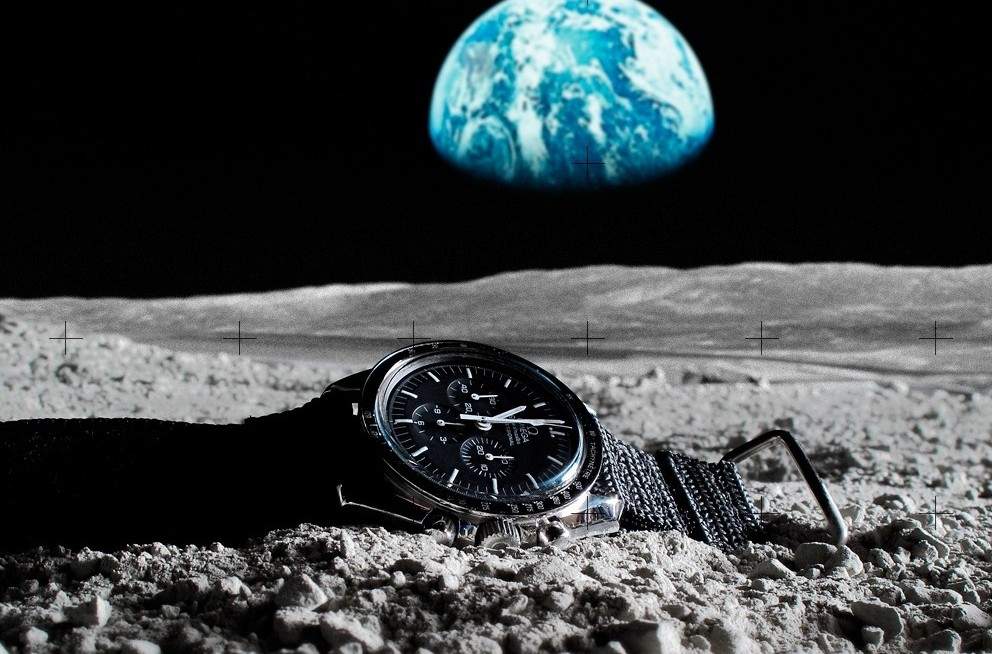
Profile of an Icon: Omega Speedmaster 2998-1
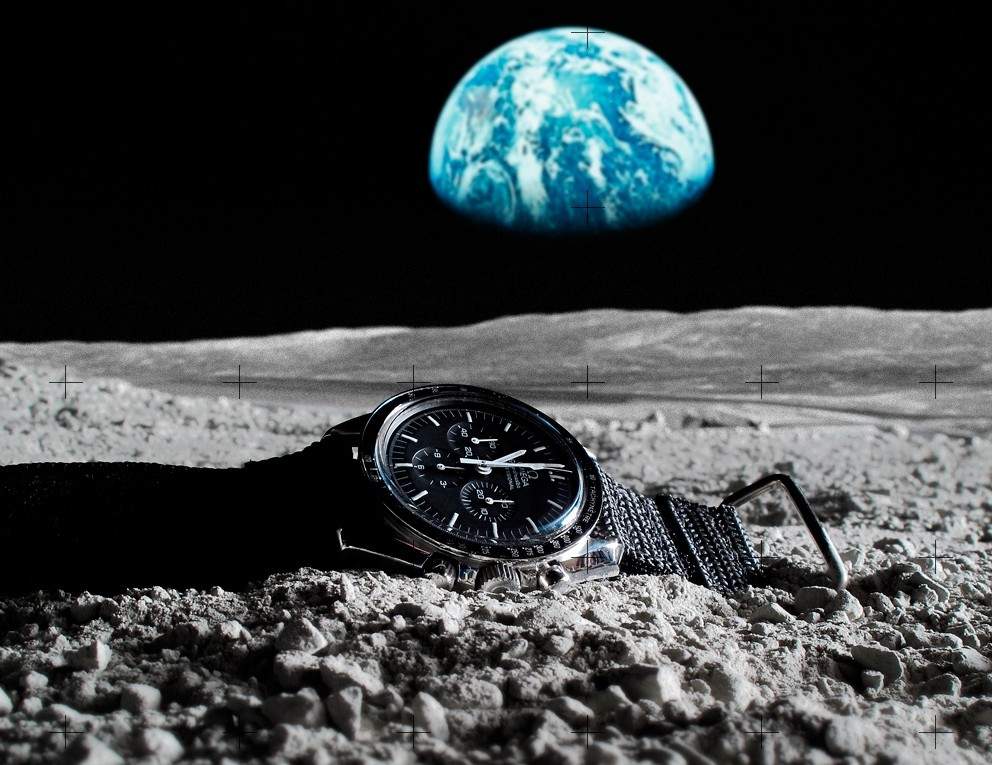
Type the word ‘Icon’ in the Merriam Webster dictionary and the following appears: An object of uncritical devotion.
For me an Icon is something that has stood the test of time. In the vintage car world a Mercedes Gullwing 300SL can proudly call itself an Icon. In vintage watches a Jaeger Le Coultre Reverso can be considered an Icon. So is the Rolex submariner.
For many collectors though one of the ultimate Icons of watchmaking and chronographs is a line from Omega. The Speedmaster.
Omega is the third most valuable watch brand on the planet (behind Rolex and Cartier see rankings here) and one thing is certain: the majority of the $3bn brand value Omega carries is due to a watch that was introduced in 1957: The legendary Speedmaster.
Initially, the Speedmaster was a success but did not gain fame and following until NASA approved the watch for their astronauts following successful testing in 1964 and the announcement on March 1, 1965. Despite great competition from the likes of Rolex and Blancpain among others, the Omega Speedmaster was the only watch to have passed all the strict tests imposed by NASA such as heat, coldness, temperature pressure, humidity, shock absorption, high pressure, vibration and lastly acceleration (for all the specific tests by NASA please click here).
After 1969 (when OMEGA watches did make it to the moon) all Speedmasters gained an inscription on the case back celebrating the Speedmaster as the first watch to be worn on the moon.
However we are going look at the early Speedmaster watches also known as ‘Pre- moon’. It is these watches that are the most sought after by collectors and for good reason. They are the most beautiful and ‘pure’.
The most important Speedmaster References: CK 2915 & 2998 (1-3)
The first Omega Speedmaster reference was the CK 2915 (see picture here).
Also known as the ‘Broad Arrow’ this first Speedmaster is extremely collectable and rare. There are two issues with the CK 2915 that collectors should be aware of. First because of the values of these watches ($50′ooo and above) there are many bezels and hands that are not original. The collector has to be very cautious and do his homework.
Secondly most of the CK 2915 came with a steel bezel. From an aesthetic point of view some find it less attractive than the black bezel but we can all agree that it is less easy to read than the black bezel (Omega changed the bezel to black to improve visibility) which was found with the next reference 2998 -starting with the 2998-1.
We believe, although not the most valuable (even if it is not far behind), the Ref 2998-1 to be the most beautiful Omega Speedmaster.
The 2998 references can be broken down in three series. It is the first series or 2998-1 & 2998-2 which we will look at in depth.
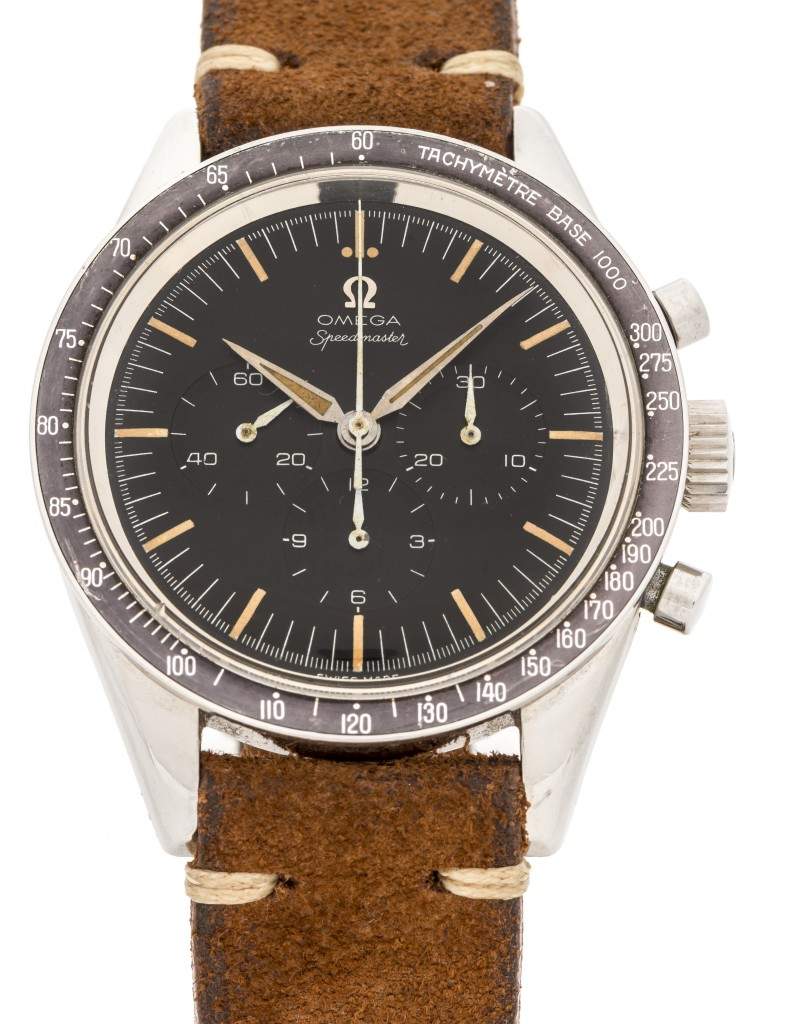
(picture credit: Roy & Sacha Davidoff – Geneva)
The 2998-1
The first Speedmaster, 2915, the broad arrow, is much admired for its purity.
Omega did not change much, but rather improved, with the next reference the 2998-1. As with the broad arrow, the second generation Speedmaster 2998-1 had no crown guards (Omega would first introduce crown guards by way of an asymmetrical case in 1964 with the 105.012 model, starting with the 105.012-63 first delivered in 1964).
While the CK 2915 had an hour hand that was in form of an arrow, the 2998-1 now had dauphine or alpha hands. Another difference was the bezel, which was now found only in black (only the very first batch of the 2998-1 still had the steel bezel). The 2998-1 carried the famous 321 Calibre movement of Lemania which launched the caliber in 1942 under the same 27 CHRO 212.
Like the broad arrow Speedmaster, the 2998-1 still did not carry the word ‘Professional’ on the dial (that would come later). The luminous indexes are also still radium at this point and only SWISS MADE is noted at the bottom of the dials without T on each side. The legislation banning Radium for Tritium was only passed a couple of years after the 2998-1 references. The 2998 references were produced between 1959 until roughly 1962.
The dial

(picture credit: Roy & Sacha Davidoff – Geneva)
Various dials existed for the 2998-1. The first and most rare version is the transitional dial from 1959 and was also used on the last batch of the 2915-3 watches. Notice the Oval ‘O’ which looks more like an ‘O’ that some-one sat on rather than a round ‘O’. This is from a very early 1959 watch as is expected for any first series. The other watches that came after the first series 2998-1 (still a 2998-1 dial) looked more round in form like this watch here. Notice how the O is more rounded.
The bezel
The Tachymetre bezel should indicate BASE 1000 which is absolutely correct and a must for the Ref 2998-1a nd 2998-2 (see below). Just to note all these bezels are based on a 1000 scale, but only the first series actually indicate this mention.

(picture credit: Roy & Sacha Davidoff – Geneva)
Although several versions of the tachymetric bezel with the word ‘Tachymètre’ exist, each corresponds to specific years or series.
The first is the steel bezel for 2915, in two versions, but both either are correct it seems. These are impossible to replace and the modern service ones are clearly different while some fakes have surfaced out of Germany which are a bit more difficult to detect. Then, Omega adapted the more legible black BASE 1000 bezel only found on references 2915-3, 2998-1 & 2998-2.
Afterwards, the (dot over) 90 bezel, which we have seen go from a few hundred dollars on ebay to a few thousand these days. I can’t imagine what the black BASE 1000 bezel is selling for…. Maybe 10 times that by now. These are particularly useful as they are used from 2998-3 reference all the way till 145.022-69 moonwatch ending in 1969 or early 1970.
Hands
Many 2998-1 watches do not carry the correct hands.
Several details are important including the length of the minutes hand, the shape of the hours hand, the ‘leaf’ counter hands and several variants of the center chronograph seconds hand, which even include the collector favorite lollipop chrono hand. First the minute hand must extend to the end of the dial and exactly touch the scale of the watch where the minute markers begin as the picture clearly shows below.
Also very important is the fact that the hour hand lume is usually triangular in shape in the earliest 2998-1 models (see picture below).
The hands of the subsidiary dials of the 2998-1 should be all in ‘leaf’ form and not in ‘stick’ form which was first to be found in later versions. The lollipop chronograph hand on these models has not been observed on the very first 2998-1, but the reference was the first to have this feature on the tail end of its production.

(picture credit: Roy & Sacha Davidoff – Geneva).
The movement 321 Calibre by Lemania
Most lovers of fine chronographs agree on one fact.
One of the most beautiful and best movements for chronographs came out of Lemania which supplied the biggest and finest names in watchmaking: Patek, Vacheron and Breguet. In fact when Lemania introduced the legendary 321 movement it was an official subsidiary of Omega.
Known for its column wheel controlled chronographs, Lemania also added magnetic fields and shocks which would prove to be important for Omega when NASA did its strict testing for the Omega Speedmaster for space. The Omega 2998-1 Speedmaster carries the legendary movement 321 Calibre by Lemania.
Look at how harmonious the movement is below. It is estimated that the power reserve of a Lemania 321 movement is approximately 50hrs.

The Inside case back
The inside case back is pretty simple and carries the stamp of the model 2998-1. Unlike Rolex which often carries the date inside no date stampings can be found in the Omega 2998-1 model.
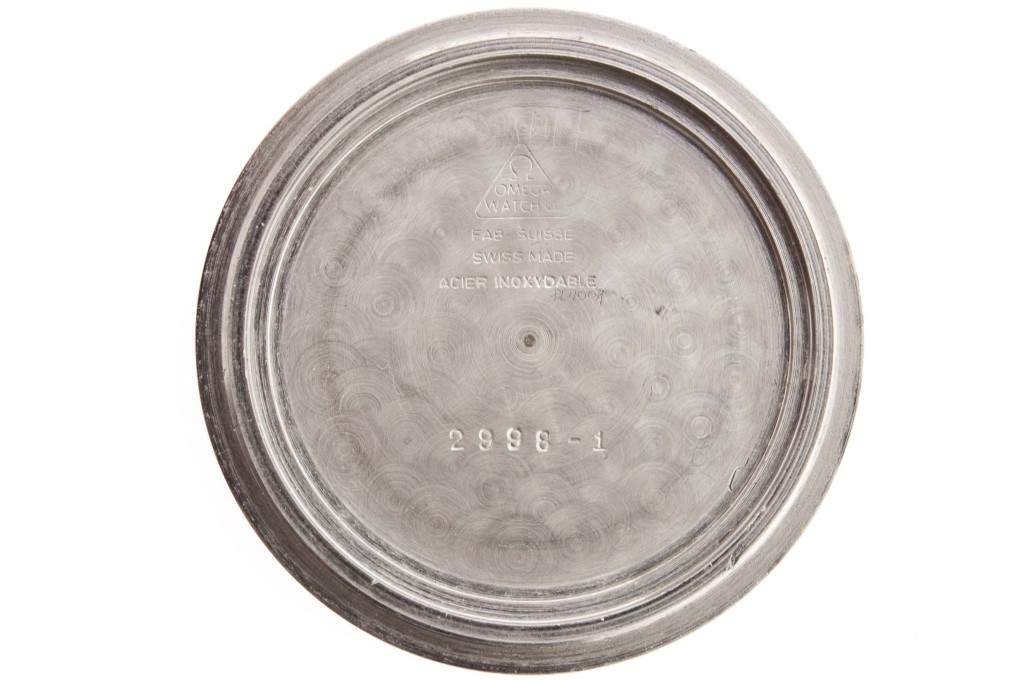
The case back and case of 2998-1
The case back of the Omega Speedmaster 2998-1 shows a little hippocampus logo and Omega Logo along with Speedmaster (see picture below) which would stay on all subsequent Omega Speedmaster models.
The early CK 2915-1 or broad arrow had a naked case back, only ‘Speedmaster’ was written on the edge of the case back while the hippocampus was introduced on the CK2915-2.
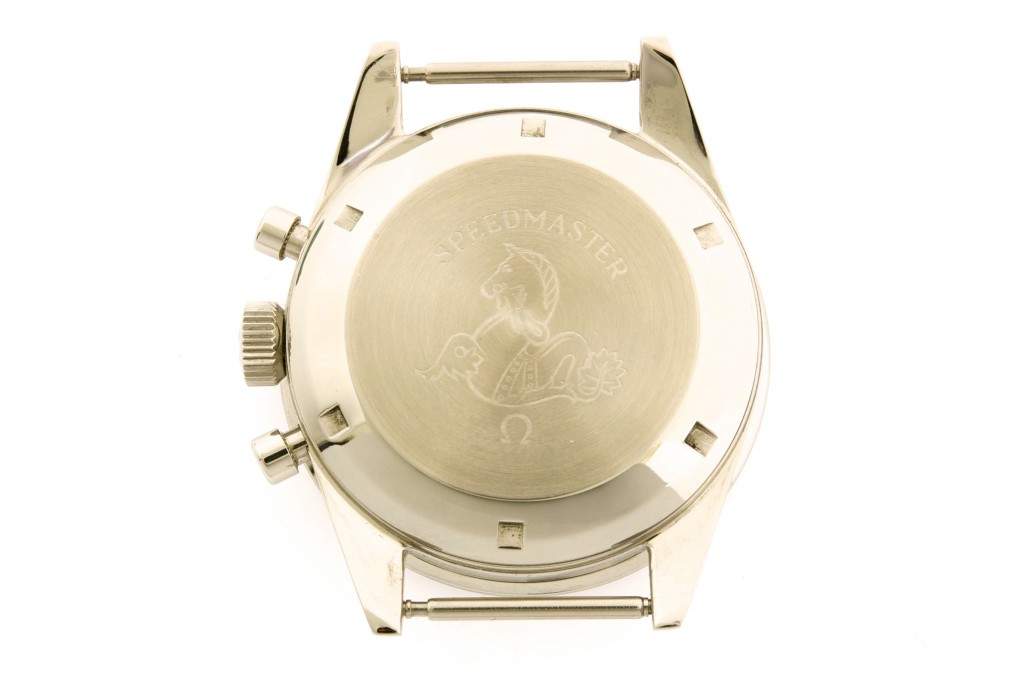
The side, pushers and plexi of the 2998-1
Below is a side view of the 2998-1.
The correct pushers should be 4mm in size, on subsequent references Omega enlarged the size to 5mm. The correct plexi on an Omega 2998-1 is superdomed.
Notice the absence of crown guards on the early 2998-1 models. Also while the CK 2915 was a fine watch it did not get high marks when it came to water resistance.
So with the next model the 2998-1 Omega also added the ‘O-ring’ gasket around the push buttons to improve water resistance.
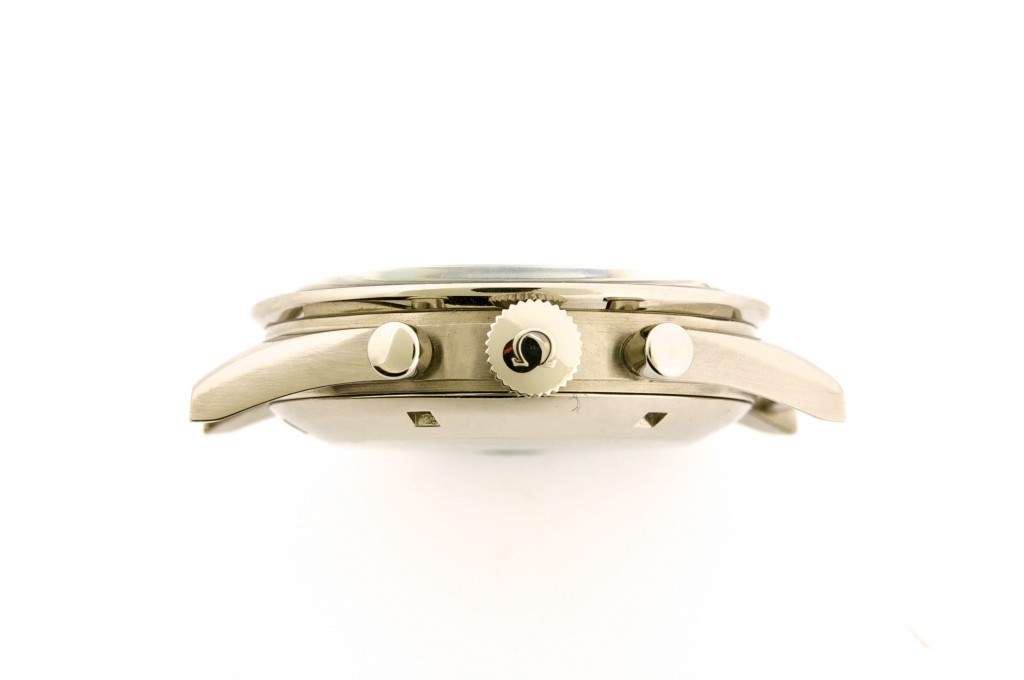
The Crown of the 2998-1
The crown on the 2998 -1 should correctly carry the Omega logo. The size is 7mm (see picture below).

Serial Nr and Model Nr for the Omega Speedmaster
As mentioned before the CK 2998-1 was produced from 1959 to 1962.
The first ever model the Omega Speedmaster CK 2915 or broad arrow was produced between 1957-1959. Below is a small table* to see what serial number to expect from the early Omega Speedmaster models. For a complete list of Case reference Nrs you can consult Roman Hartmann’s list, to be found here.
Year Model type Calibre Serial Nr
- 1957 CK 2915 321 14xxxxxx
- 1958 CK 2915 321 15 /16xxxxxxx
- 1959 CK 2998-1 321 16 xxxxxxx
- 1960 CK 2998 321 17xxxxxxx
- 1961 CK 2998 321 18xxxxxxx
- 1962 CK 2998 / ST 105 321 18/19xxxxxxx
Concluding remarks
It is no exaggeration to state that the Omega Speedmaster is one of the most successful watch models ever launched in the history of watchmaking.
It is up there with the Rolex submariner and Jaeger Reverso.
When NASA approved the Speedmaster above five other brands in 1965 its place in watchmaking history and Iconic status was assured. It is estimated today that the majority of Omega’s brand value of almost $3bn is mainly due to the Speedmaster line. Every watch collector and every collector of chronographs cannot call his collection complete without an Omega Speedmaster.
While the first series CK 2915 broad arrow are the most sought after and valuable, we think the most beautiful and elegant early Speedmaster is the second model Omega introduced in 1959 called the 2998-1.
______
Article co-written by Sacha Davidoff an expert on Speedmasters and on vintage watches based in Geneva. He co-owns Davidoff Brothers in Geneva and their website is www.db1982.com
(Main picture credit: Jacques Olivier of Purist. It shows a later Speedmaster with the word Professional on the dial and crown guards). *Credit for the table goes to Robert Hartmann.
For collectors looking to understand the Speedmaster in more detail we highly recommend Moonwatch Only book written by Gregoire Rossier and Anthony Marquie published by Watchprint. This book has a very good technical overview of each component as well as each reference. Another useful book for pictures is the John Goldberger book on Omega.
Below are some pictures and advertisements to complement the report of the Speedmaster 2998-1 above. First picture is a CK 2915 also known as the broad arrow (Credit John Goldberger).
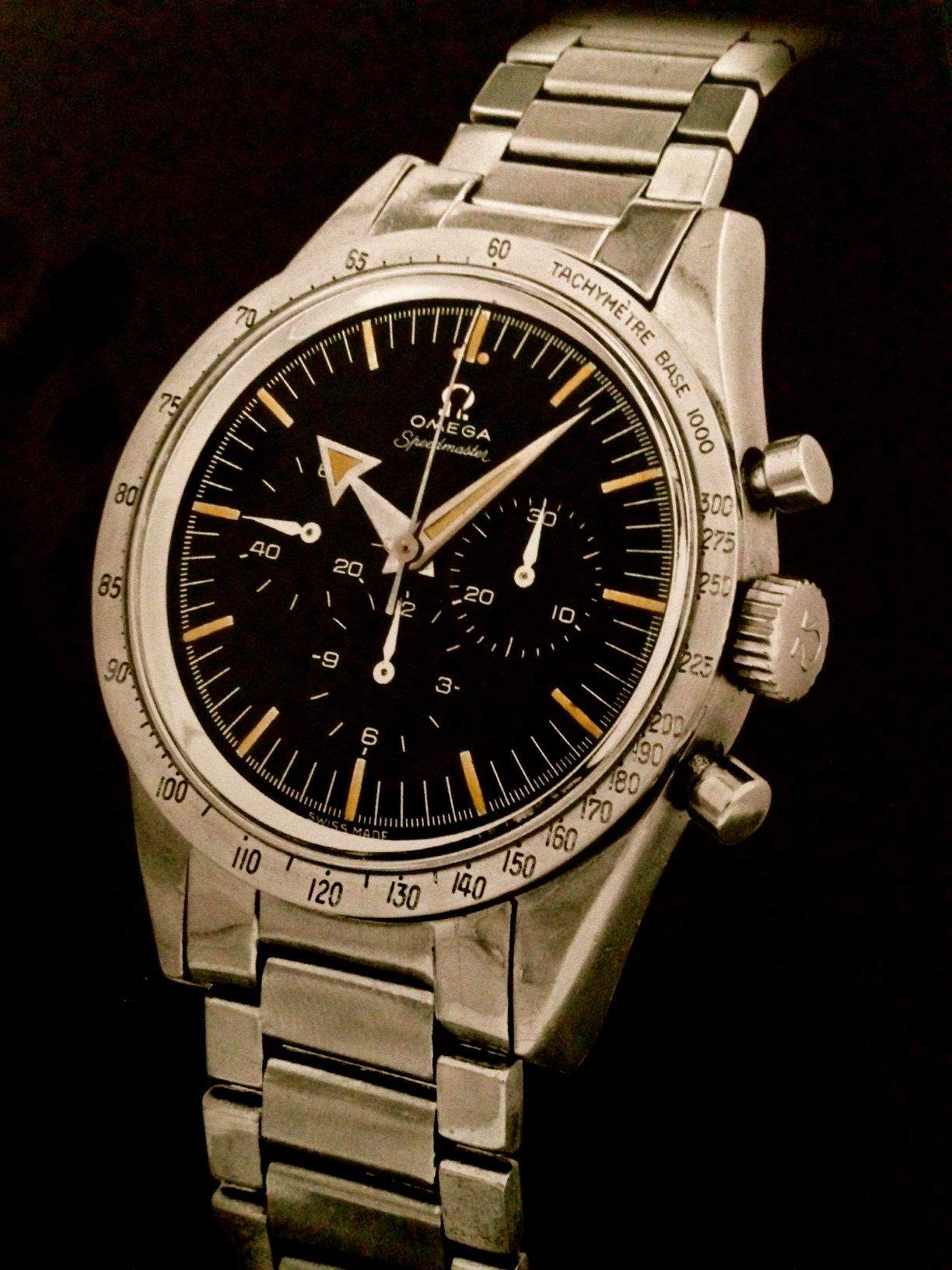
Several 2998 Speedmaster watches have the rare Lollipop seconds hands as seen below. Notice the marvellous tropical brown dial (picture credit: Roy & Sacha Davidoff Geneva).

Several bezels existed of the 2998-1. Below a 1000 Tachymetre.
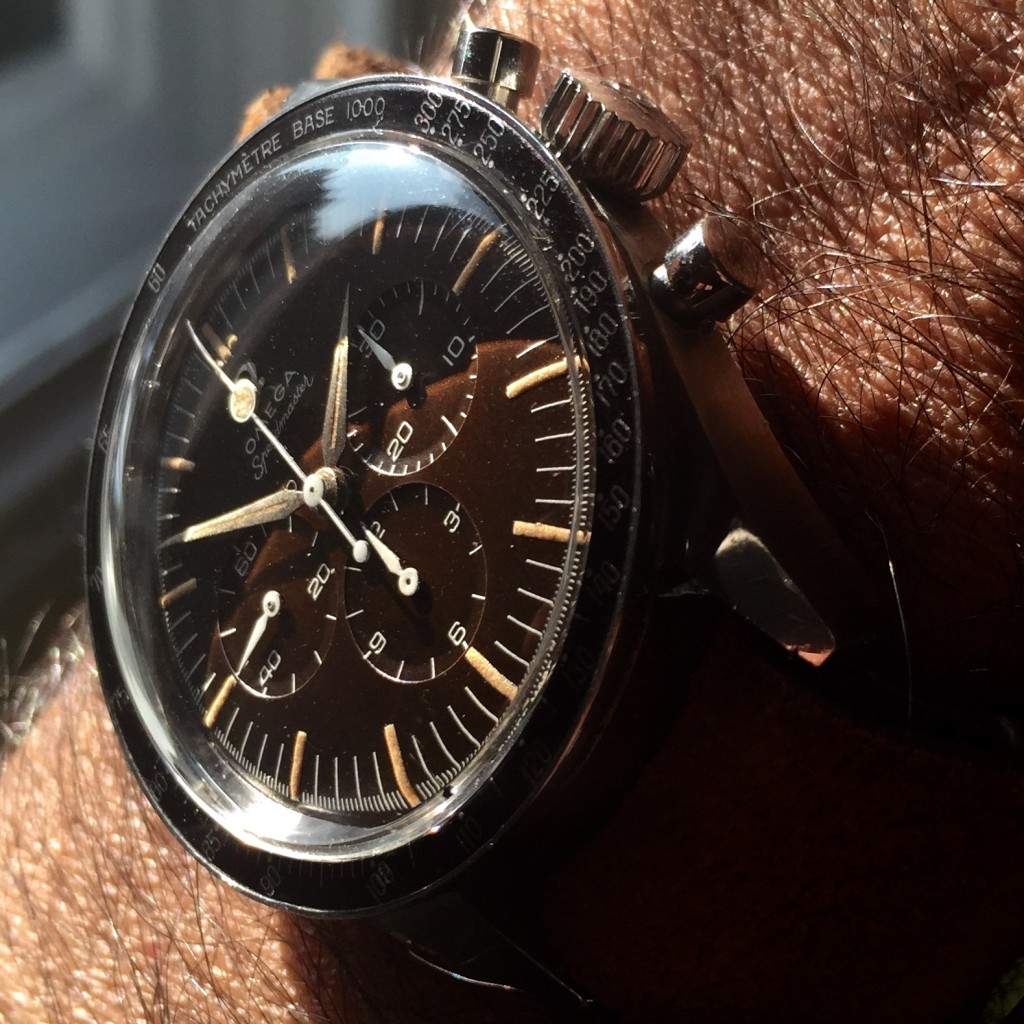
Another exceptional example with the rare 1000 Tachymetre rating is owned by a Middle East collector Hatem Fawzy (see watch above).
Notice the lightly turned ‘tropical’ dial (see watch below). This watch also has the rare large lollipop seconds hand. This watch is one of the best examples of a 2998-1 that we have seen.
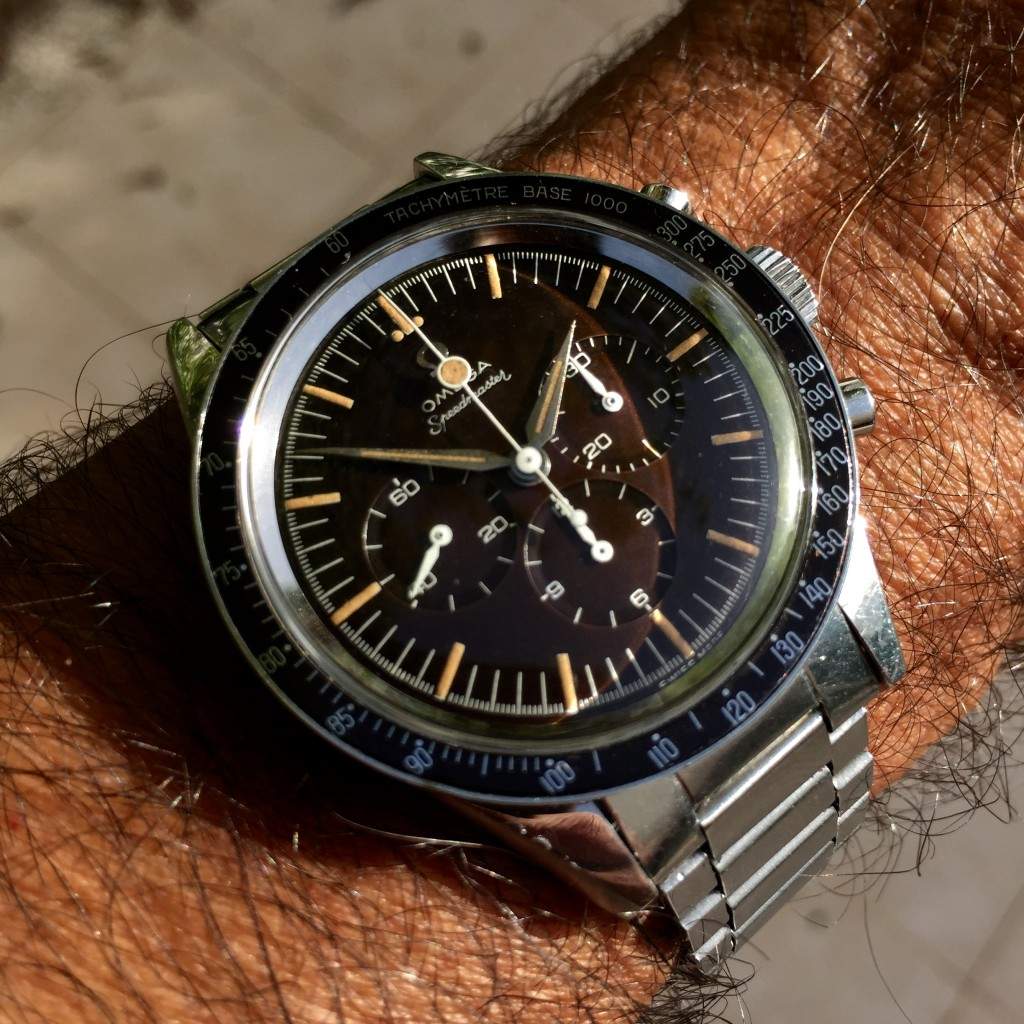
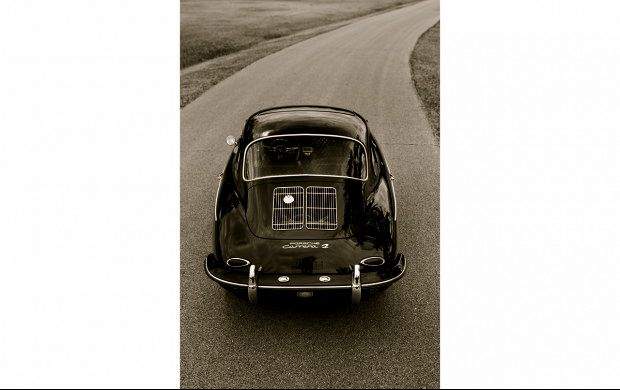
A special 356 Porsche carrera 2
When one of the most important cars Porsche ever made comes up for sale, collectors should pay close attention.
Long before the 911 existed, Porsche became famous for the 356 line, which was the company’s first production model.
Small and agile the 356 became a tremendous success for Porsche. Designed by Ferry Porsche, the 356 model carried a rear mounted, four-cylinder air-cooled engine. Introduced in July 1947 Porsche would go to sell approximately 76’000 356′s before it was replaced by what was to be the Iconic 911 in 1964.
Most collectors think of the legendary ‘Speedster’ model when they think of 356, made famous by James Dean* who owned one. While the speedster is sought after by collectors, there is another model of the 356 which is even rarer and more valuable than a speedster. It is a Porsche 356 Carrera 2 Coupe.
The 356 Carrera 2 was one of the last built Porsche 356s and incorporated the most powerful engine available: A 2 L engine (thus the 2 in the Carrera 2), four cylinder – 4cam ‘Fuhrmann’ engine powered by 2 solex dual -throat carburettors producing an estimated 130hp at 6’2oo rpm**. This engine was 50% more powerful than the standard 356′s that Porsche had produced and represented that best and most powerful 356 coupe that Porsche had ever built. Top speed is estimated at 2ookm/h. Only 436 Carrera 2 were ever made. Gooding & Company is selling a 1963 Porsche 356 Carrera 2 which is especially interesting. It has a factory original sunroof (which is very rare and very cool) and an enlarged special order 70L tank. Most importantly it has a correct ‘matching numbers’ Carrera engine.
Gooding estimates this 1964 Porsche 356 Carrera 2 car at $600′ooo. For more information on this car please click here.
(Photo credit Mike Maez for Gooding & Co. All images copyright and courtesy of Gooding & Company)
* James Dean did eventually die (tragically) in a Porsche, but it was not a speedster as many people think. It was a 550 spyder.
**Source: Porsche 356 ‘Driving in its purest form’ by Dirk Michael Conradt, page 249.
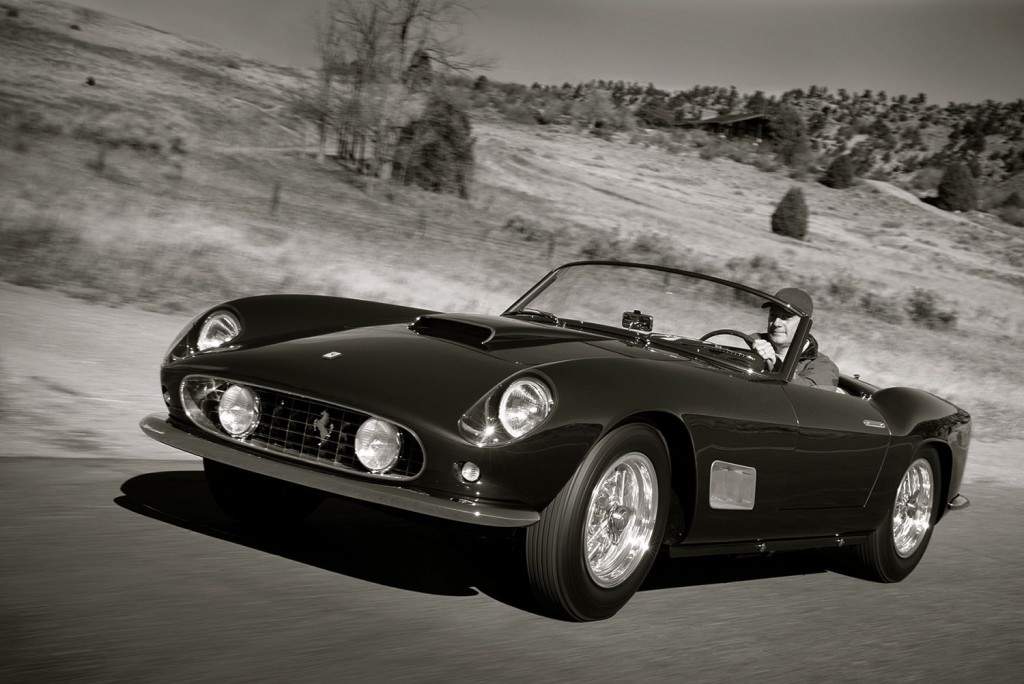
David Gooding: ‘Quality’ is his style
In the classsic car auction world there are two metrics that count. One is the sales rate (the percent of cars actually sold) and the other is average price per lot sold.
On both metrics Gooding & Company leads the classic car auction world.
Sure there are other auction houses that sell more cars than Gooding. But nobody beats Gooding in terms of quality of cars. Founded not even 10 years ago, Gooding today is a major force in the classic car auction business with sales of more than $200m for 2013.
The man behind Gooding and company is David Gooding who is the co- founder and President of the California based Gooding & Company.
David Gooding grew up around classic cars. His father was the curator the famous ‘Harrah’s’ collection so it was natural that David Gooding grew up with classic cars, including a Ferrari 275 GTB/4 that his father bought in the 1970s. David began his career with Christies International more than 20 years ago before joining RM Auctions and finally decided to set up his own firm bearing his name. Among the notable cars David has sold include: A Bugatti Atlantic Coupe Type 57SC, the very special Mercedes 540 K ‘Von Krieger’ Model, and a fabulous Ferrari 250 Testarossa Protoytype Pontoon Fender.
While Gooding is well known for carrying out auctions at Pebble Beach California, Amelia Island and at Scottsdale, the auction house closes many deals we never hear about. This is for a good reason.
When clients deal with millions of dollars per car, they want discretion and thus David Gooding handles numerous sales (35% of total sales) on a ‘Private Treaty’ basis. For his outlook on the classic car market as well his favourite cars and what mistakes collectors should avoid – here is David Gooding in his own words:
LME: How does the classic car market in 2014 look like?
Gooding: It will continue to be very strong. This is led by a number of factors. Strong economic growth, low interest rates and lastly the acceptance of cars as a good investment but also for many collectors, cars have become a form of art.
Will it be the case of the best cars holding their prices while the mediocre cars and rest get left behind?
Gooding: Yes absolutely. Longer- term exceptional cars like the 250 GTO, a 250 Testarossa, an LM or 8C Alfa will get more expensive. They just produced too few of them and the demand is growing. Having said that prices cannot appreciate at the rate they have (40% annually over the past few years). However interest in Classic cars just keeps growing. More fabulous events are being offered so much so that today you can attend a car event almost every single weekend around the world.
Where do you see demand coming from? New countries like China, India and Russia? Or just new collectors in important markets like Europe and the US?
Gooding: The classic car business has become a global market. Still the biggest market is the US. Collectors here are just more active. The highest turnover is in the US. Europeans are still not as active as the US market. The Asian markets are slowly becoming more active but there is still massive room for potential there.
Which brands are undervalued today? Maserati?
Gooding: Maserati is absolutely undervalued but so are Porsches and Jaguars. If you think of the power of D and C type Jaguars and compare prices to other brands like Ferrari from the period then Jaguar offers tremendous values. Even E-types are not yet where they should be in terms of prices. Another category that is undervalued are pre-war cars. They are very useable and often misunderstood. For example I personally own a 1914 RR Silver Ghost and in 16 days covered 2100 miles. I never had any problems! Owning a pre war cars is a wonderful and rewarding experience.
Is Ferrari overvalued or is it justified as their history is so strong and their cars just more delightful than other brands?
Gooding: No, Ferrari continues to lead the classic car market for a very good reason. There is simply nothing like a Ferrari. Take a 250 SWB. It is visceral and beautiful. You fire up the engine and it excites the senses, the engine is like music. The looks are fantastic. The feel is wonderful. There are VERY good reasons why Ferrari achieves one record price after the other!
Is it becoming harder to find good cars for your auction? It seems 4-5 years ago there were more SWB 250 for sale?
Gooding: It is indeed getting harder to find good quality cars. There simply are not many out there that meet our standards.
When I think of Gooding I think of quality. Was that your Nr 1 goal?
Gooding: Absolutely! This is why we don’t carry out auctions on a monthly basis like our competitors. We are limited in the cars we can offer as a result. Our main interest at Gooding is finding great cars that collectors will appreciate for the quality. This is our first and foremost goal.
Did you start Gooding because you thought the quality was not up to the high standards that it should be?
Gooding: My goal was always clear: To find the most unique and special cars for our clients. This takes time and while some other auction houses carry out auctions almost every other month, we prefer to do less. Not to say that the other business model of many auctions is wrong- it is just not right for us.
What differentiates Gooding?
Gooding: Well firstly quality – but also transparency. We tell the story openly and fairly.
Has the Internet become an opportunity or threat for you?
Gooding: The Internet has been a huge opportunity for us but having said that – we value the personal interaction in this business. It is for this reason that we do not allow on-line bidding. We want to know our clients as much as possible and feel also the story about our cars are best told in person.
You are mostly a US player doing auctions only in the US. Why do you leave the European market out?
Gooding: Well we are familiar in doing auctions in Europe. We have done them before. But we only do events /auctions that present a real value added for our clients. So while we do ‘Private Treaty Sales’ for our European clients and sell to Europe, we chose only to do auctions in the US.
What is the most memorable car Gooding has sold?
Gooding: Many come to mind! The Duesenberg ‘Mormon Meteor’ sold in 2004 for $4m was a clear record for a US car at the time. It is a 400hp car that averaged 135mph in 24hrs in 1935! The 250 Ferrari Prototype Pontoon Fender Testarossa sold in 2009 for $16m was also memorable of course. Lastly the 540 K Mercedes Benz ‘Von Krieger’.
Now and then you find a true ‘barn find’. What is the craziest barn find story you can tell us?
Gooding: Clearly the Von Krieger Special Roadster 540 K. I first stumbled upon this car in the 1990s working for Christies. Someone had faxed me a copy of the picture of the car. Can you believe it was locked away with other storage equipment?! The deal to close this car (the car was sold by us finally in 2012) took so long because the estate was very complicated. But it was worth the wait. It sold for a record price. The story of that car is a very human story and that is why so many potential buyers and the entire classic car world could relate to this unique car.
How did your interest in classic cars start? Are you also a collector?
Gooding: From my father- he was the curator of the Harrah’s collection. He had a 275 GTB 4 cam when I was small so that influenced my passion for classic cars. I grew up in automotive museums and in automotive libraries. Today my family and I collect and own a Mercedes 300SL. I also own a fine Aston Martin DB4- which was a one family owner car before I bought it.
What is/ are your favorite brands?
Gooding: Although I like many brands, I tend to fall in love with the individual car before brand. So to give you an example I like Aston Martin – but I bought the DB4 not because I am a huge Aston Martin fan necessarily but rather because the car fascinated me so much. It was a one owner car. So the cars often draw me because of their history rather than because they belong to a specific brand.
What do you do when you’re not working? What are your hobbies?
Gooding: I am interested in politics and art. I recently have also started to get excited about wristwatches. But my life really revolves around cars – even in my spare time. My wife and daughters love cars and we often go on rallies together.
What advice would you give to collectors starting to collect?
Gooding: Three things. 1) Ask as many questions as possible about the car 2) Buy out of passion of what you love- what speaks to you 3) Buy something because it moves you and buy the best example you can find. This way you can always pass on the passion to the next person someday.
What are the most common mistakes collectors make?
Gooding: They pay to much attention to what the potential returns on their investment. Instead they should be buying a car because they will use it. Cars are meant to be enjoyed. The memory and experiences you create using your cars is priceless. You cannot buy that.
Now I ask Gooding to answer these questions spontaneously;
- A 250 GTO for $100m in 2020 or 2030? 2020 -possibly before!
- The food in California or New York? California!
- One day spent with Uhlenhaut or Enzo Ferrari? Uhlenhaut
- A Maserati 3500GT or an Aston Martin DB4? A DB4- I am an owner
(David Gooding, President and Founder of Gooding & Company, driving the record setting 1958 Ferrari 250 GT LWB California Spider, which sold for $8,250,000 at Gooding & Company’s 2013 Scottsdale Auctions)
Image copyright and courtesy of Gooding & Company. Photo by Mike Maez.

Eric Ku: the man in charge of the Vintage Rolex Forum

Since September last year – there is a new man in charge of the VRF.
To those who don’t know the VRF stands for the Vintage Rolex Forum and is one of the most heavily visited websites dedicated to watches in the world.
VRF gets over one million page views per month and collectors from over 158 countries around the world seek to improve their knowledge and trade with each other and discuss the most valuable watch brand on this planet, Rolex. So who is this new owner and man in charge of VRF? His name is Eric Ku.
When he was in college he started trading Rolex watches and has since become a well known ‘super dealer’ when it comes to vintage Rolex. His dealer name is 10 past ten (his website is here). Many of the great Rolex watches have past through his hands. Ever wonder who set the world record of a Jean Claude Killy Rolex ref 6036 in pink gold? It was indeed Erik Ku who will go to any measure to secure the best Rolex for his client.
To find out more about the man in charge of VRF and his advice on collecting- please read on:
LME: Late last year you have become the new owner of VRF (Vintage Rolex Forum). Tell us more.
KU: Yes, in September of 2013, I officially took over the reigns of the VRF from Richard Carver. I took it on as both an honor and challenge, as I know its such an important resource for many.
VRF has been instrumental in allowing me to better understand vintage Rolex watches. I never buy a vintage Rolex (if I have doubts about the watch) before checking with VRF. I assume there are many others out there who also seek VRF on a daily basis. Is this your goal?
KU: Maybe not my goal, but again it is an honor to me that this is a sentiment that many collectors share. I see VRF as a great tool for both new and seasoned collectors to ask questions, give answers and share exciting things with like minded people. Looking at the analytics, I was surprised that VRF is viewed by collectors in 158 different countries!
Do you view VRF has primarily an educational tool? Or what else do you hope to accomplish with this network?
KU: The market for vintage watches and especially vintage Rolex watches can be a minefield. I see VRF as a place where questions get answered, myths get debunked, debates take place about the esoteric minutiae that collectors are fixated by, and we can all share in the journey. As well as the main forum which is an educational tool, we have a very active sales forum called Vintage Rolex Market (VRM). It gets nearly a million page views a month, and is perhaps the safest place on the internet that people can use to find and sell their vintage Rolex related items.
You started dealing with Rolex already at University. Tell us more.
KU: I always loved watches, but through a stock market investment in college where I made a modest profit, I could finally buy what I thought was “a nice watch.” One quickly became two, then three, then what the stock market giveth, it taketh as well, and I was left with no watches! In this very short period of time, I realized not only did I love watches, but I also loved the mechanics of the buy and sell. A dealer was born.
Prices of vintage Rolex were on tear last year. Is it sustainable?
KU: It always concerns me when prices rapidly increase, and the word bubble always gets tossed around. I generally am not fond of the “monetization” or “commodification” of watches, but realize that the money spent on them now is quite staggering. I don’t have a crystal ball to predict the future, but I can say that if you buy the best examples- history has shown us that you can’t go wrong!
Rolex is a foundation and does not give information out on their vintage models. They don’t help collectors in the way other brands do by issuing certificates. Will that ever change?
KU: Doubtful. Rolex is not like Patek Philippe- it makes a significantly higher volume of watches, and perhaps their records on older watches are not as good as they should be.
Rolex does a lousy job paying tribute to their past with the current models. Agreed?
KU: They are “In the Spirit” of the older models, but distinctly modern. Although this may not be everyone’s cup of tea, I personally find it better than the shameless “reissue” phenomenon that is gripping the watch world. Everyone keeps reaching into their history, what happens when there’s nothing else left to reissue?!
Collecting Rolex is like swimming in a tank full of sharks. Its bloody dangerous. There is more forgery in vintage Rolex than all the other brands put together. How can we protect ourselves?
KU: Know the seller and do your research! We all make mistakes and big or small, they all hurt. The best thing is to develop a relationship with a reputable dealer, and take your time. A good dealer has nothing to hide, and a guarantee of authenticity should not have a time expiration date.
What are the most common mistakes Rolex collectors make?
KU: I think collectors now too often think with their wallets and not with their hearts or minds. Too many times people go for “The Good Deal” and not “The Good Watch” or they end up buying the watch they thing is going to be the better investment rather than the one they really like.
With the Daytona Christies sale last year, the Daytona has become the most valuable line within vintage Rolex. Why?
KU: There has always been an allure to the Daytona. Its association with the sexy cars and celebrities like Paul Newman. For the last 10+ years, even non watch collectors know that a steel Daytona is collectible and worth more than what it cost. This type of awareness is something that you can’t pay for or get from an ad campaign.
What is your favorite line within vintage Rolex? Why?
KU: I have always been an Explorer I fan. I’m a big history nut, and find the allure of Everest and exploration far too great. It boasts no complications per-se, but the Explorer -1 is always a classic.
Why does an ideal Rolex collection look like to Eric Ku? Lets say you have a budget of USD 250’ooo and can chose up to three watches maximum.
KU: The following three watches:
- 6241 Black 3-Color Paul Newan
- 1803 White Gold Stella with Yellow Dial
- 5510 “Big Crown” Submariner
Tell us of your most crazy Rolex story you have experienced!
KU: My first nice vintage watch I got was a 6536/1 Sub in MINT MINT condition with box and papers, which was acquired from the original owner’s son. It was purchased on the 4th of July in 1957 and was bought as a gift to himself when he started his new life in America. I sold the watch for a quick profit and immediately regretted it. The $1,000 profit was far too great a lure for a broke college kid! Lets just say it took 14 years a lot of persistence and a big check to have it back in my possession!
What other brands speak to you as a watch collector?
KU: I am a big fan of the independents. I love Philippe Dufour and Laurent Ferrier for the beauty of their finishing and representation of the ultimate understated dress watch.
Besides VRF what blogs and internet sites are you a user of?
KU: I consider myself lucky to be friends with Ben Clymer and I’m a big fan of his website Hodinkee. Besides watches, I love cars and read the blogs Jalopnik and Autoblog religiously.
Now I ask Eric to chose one or the other or none.
- A Submariner 6538 or 6240 Newman? 6240 PN
- To have lunch with Killy or Newman? Newman
- The first $1m submariner: 2015 or 2020? Already close
- If Putin would wear a Rolex he would chose: Green Milgauss
(For our post on the importance of social media like the Vintage Rolex Forum please see our article here)